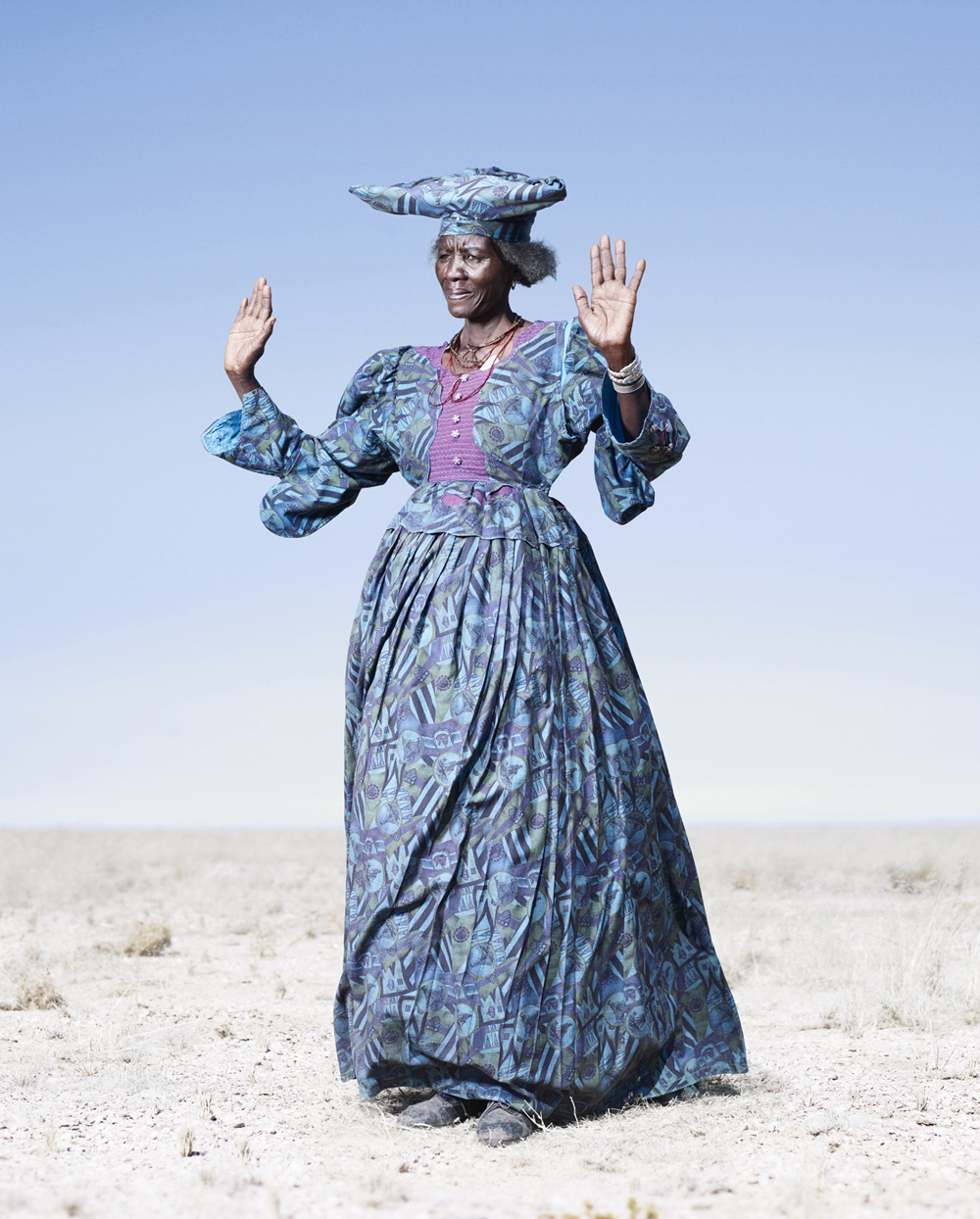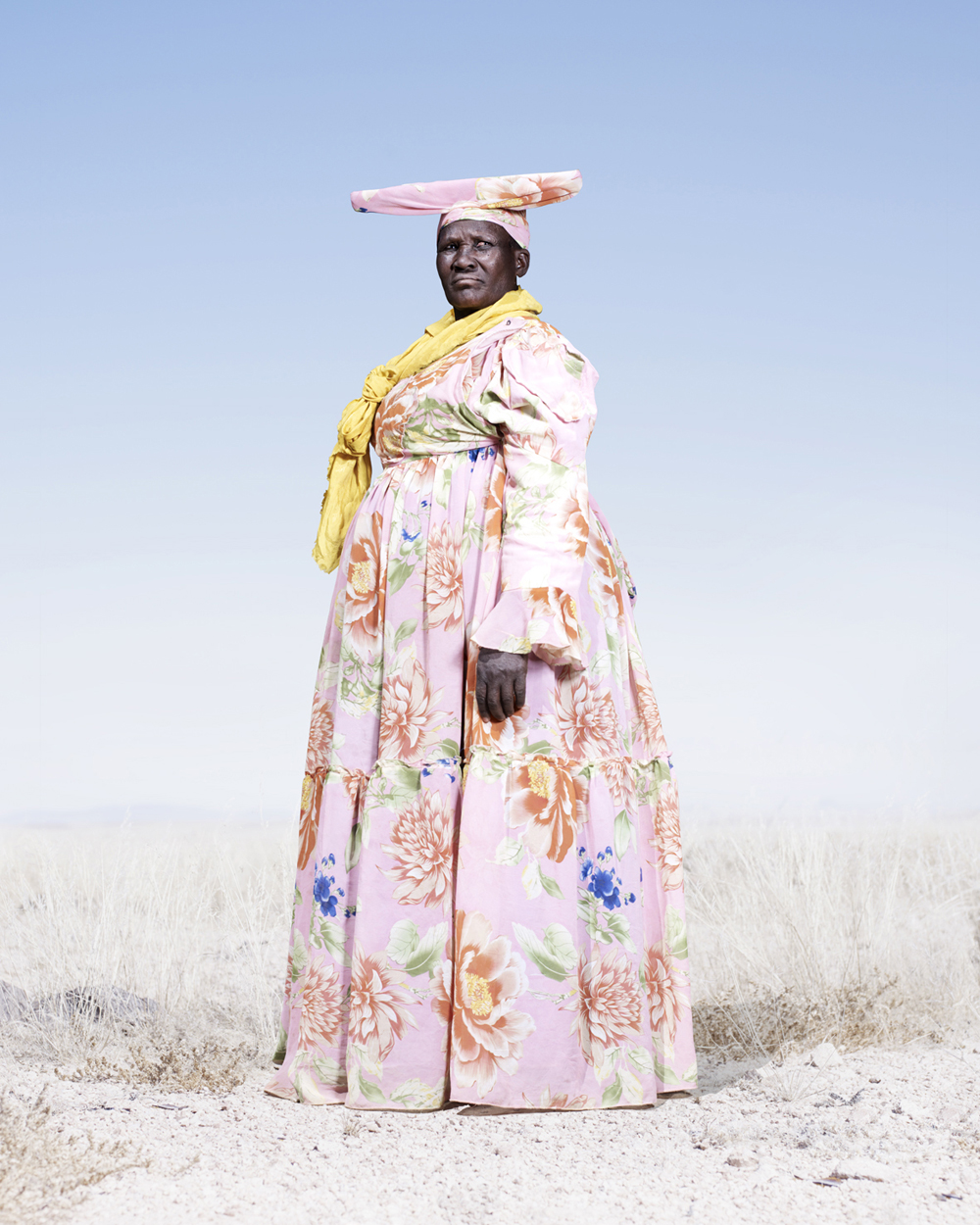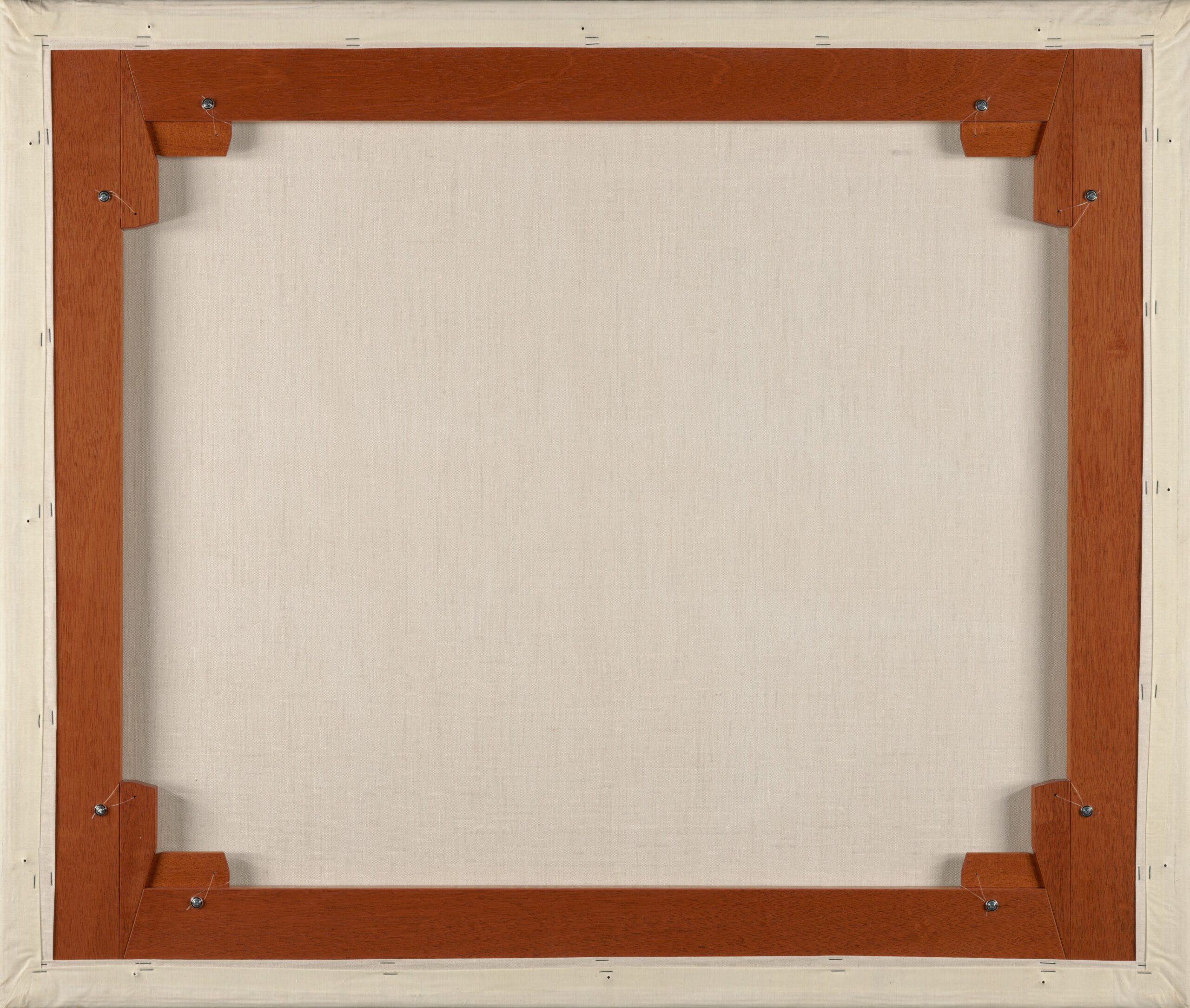interview by Darren Ching and Debra Klomp Ching
Herero Woman in Patchwork Dress 2 ©Jim Naughten
At Length: There has been a phenomenal amount of interest in your photographs about the Herero people of Namibia. Much of the press has focused on two main things: the perceived exoticism of the Herero people themselves – or rather their clothing – and the turbulent history of their country. What do you think about the attention your work has received thus far?
Jim Naughten: I had expected a certain level of attention, but nowhere near as much as there has been. The way the work has caught on on-line – websites and blogs — has been quite phenomenal, and there’s a very definite difference between the level of interest in “Re-enactors” and this series in terms of what’s changed over a four year gap and the increased amount of blog or internet content being used or seen now. The actual images are quite “loud,” overtly colorful, and therefore eye-catching. Although they have been made to be exhibited in print form, they translate well on a computer screen, so that has certainly contributed. Lastly, the story behind the costume is fascinating and little known, and overall it has quite a broad base of interest – covering portraiture, fashion, history, fine art, anthropology, and so on – increasing the potential audience base.
AL: Merrell has published a book on the work. How did the title “Conflict and Costume” come about?
JN: My initial idea for the book was to simply call it “Hereros” and to have a similar aesthetic to the “Re-enactors” monograph. Merrell suggested “Conflict and Costume” as a way of leading people into the story behind the costume. They are a very successful publishers with a good reputation – with a highly lauded designer, Nicola Bailey – so I decided to trust their judgment, and I think they have done a great job. It’s a different book to the one I would have made, but a very good one nonetheless.
Herero Soldier in Red Beret ©Jim Naughten
AL: The book has garnered quite some attention in its own right. Something that keeps coming up is how little is really known about the Herero people from a historical perspective. How important is this to the series of photographs from your perspective? And from the perspective of the publisher, in that there’s an essay in the book that deals with the historical aspect?
JN: I tend to find a subject that interests me on several levels, one that I can explore photographically and artistically, and in the case of these last two projects, subjects that have or make a connection with history. I read a great deal of history books and I like to imagine my work as being kind of illustrated versions. The fact that the Herero story – or the story behind the German/Herero war – is little known adds a certain weight, and it is fascinating to consider the paradoxical nature of the story. I think the book needed to have a contextual essay, as the central subject of the images is real and historical, despite the images having a strength of their own.
AL: Do you think this is contrary to the photographs existing as fine art; i.e., is there a possibility that readers might view the photographs as a form of journalism/documentary?
JN: I think there is a gray area where art and documentary meet. I think these images are probably right in the middle, exactly where I want them to be. I would cite Werner Herzog as a strong influence in terms of my practice, in as much as his documentaries are often scripted or bent into his “ecstatic truths,” with actors, scripted scenes or the luxury of soundtracks to alter what we are seeing. I try to think of my images in this way, like paintings or films, and see where I can take them with post-production to make them my own.
Herero Woman in Red Dress ©Jim Naughten
AL: Tell us about how you became interested in the Herero people.
JN: I travelled across Southern Africa for a year after finishing college and came across the Hereros during that time. I photographed them then with my old film camera, about fifteen years ago. I always had it in the back of my mind to return and photograph them again, this time with a clear idea of making a large body of work, using digital capture and post-production, and a much clearer process behind my picture making.
AL: When you returned to Namibia, what was the process you undertook in order to make these photographs?
JN: The process of image making was logistically tough and quite physical. It took about four months and I brought an assistant out with me from the UK, and hired a car and Herero guide from a Herero tour company — a real coup. We camped every day, drove for thousands of miles staying in villages, visiting weddings, funerals, and ceremonies across the whole country, photographing as and when we could. Our guides were key to the process and they would introduce us to chiefs and elders, explain what we wanted to do, and negotiate fees, or gifts for the villagers – usually coffee, sugar and maize. In this way we made sure we could proceed respectfully and spend a great deal of time talking to the people I was photographing.
AL: Was it difficult and how? What were the main challenges you faced photographically as well as practically?
JN: It was quite physical in the sense that we camped every day, putting up the camp, cooking, cleaning, striking camp, driving huge distances – rarely on road – trying to charge the equipment, cameras, lights and laptop, keeping the sand and dust out of the kit and backing up. We had to watch out for scorpions, snakes, spiders, and the occasional elephant or lion. It does require some staying power for four months. On top of that, there was the challenge of finding the subjects, negotiating with them and then of course taking the photographs.
Herero Woman in Blue Dress ©Jim Naughten
AL: This series of photographs is your second body of work as a photographic artist, the first being “Re-enactors,” where you also made photographs about history, about costume and about identity. How would you say you’ve developed as an artist with this new work?
JN: This body of work represents a kind of backward step, but one that I wanted to – or felt I had to – make before making a big forward step on the next project (due to start very soon — watch this space). There was an itch that had to be scratched.
One thing it has done is reinforced how important post-production is to my practice, and how much my painting background is merging with my photography.
It’s perhaps another conversation, but I read an interesting interview with Tessa Traeger, where she says of digital technology “To my relief and surprise this new medium has proved to be subtle and flexible and ripe with infinite possibilities, especially in color, and the ability to make the image exactly as you wish afterward. Now it is possible to make images which you only see in your head before their creation.” This really echoes the form and direction of my practice. In addition, I have been a fan of Roger Ballen, and I’ve always been aware of the moment where his work changed from documentary to art. Despite my work mixing both of these already, I am intending to make my own version, or to “do a Ballen,” as I think of it, next.
Herero Cadet in Blue Hat ©Jim Naughten
AL: On purely scopic terms, the photographs are fascinating. The vantage point, focal depth and use of light are at once simple, yet so complex and highly crafted. Why did you make the photographs in this way?
JN: I wanted to make a set of images of the Herero dresses and uniforms and set them against the expansive landscape which, other than an aesthetic or dramatic choice, would both focus the viewer’s attention on the subject and add a sense of space, ambiguity and timelessness to the photographs and story. The backgrounds work as a kind of backdrop, and suggest a hidden history — the desert as silent witness. They are not ‘documentary’ images, but a of study and kind of celebration of the costumes, which are spectacular, so I wanted the images to reflect this. The photographs have been described as painterly, which is what I had hoped for.
To achieve this, apart from photographing the sitters in the midday sun with a silver strobe light to fill in most of the harsh shadows – which adds to the sense of surreality – a great deal of the work is done in post-production. Whilst some of the images are made in situ, the majority, where subjects could only be photographed in towns, for example, have been added into a landscape and had work done to alter the colors and shadow detail. Some images are made up from several different elements. For example, the panoramic images are made up of several different images, usually photographed in sequence from one position – like the marching ladies – and then added into a landscape in post-production. It feels wonderfully liberating to work this way, and much closer to painting.
Herero Woman in Pink and Pattern Dress ©Jim Naughten
AL: The color also performs a crucial role, not just in terms of the Herero clothing, but how you utilize it as an artist. You used a very specific color palette in your previous work also. Tell us more about this.
JN: In terms of the color palette, I would say that I don’t think I’m capable of making a normal color photograph. I have always worked with an abstraction of color, whether it be as a black and white photographer, using cross processing in color photography, or hand tinting, but never anything resembling ‘real’ color. As I mentioned before, I’m beginning to realize just how important the digital process is to my work. It’s more-or-less made for me, allowing me to take the work wherever I want to. This is true of both projects, “Re-enactors” and the Herero series. I have to mention Loretta Lux, as she was the first person whose work I saw that appeared to be part of a great photographic tradition, but who was clearly using digital process and a painterly color palette. It’s a wonderful way to describe the images or story in my mind’s eye, and I always consider how I might approach these subjects as paintings.
AL: Each of the subjects is ‘bang smack’ in the middle of the frame — yet you don’t seem particularly concerned about the identity of the individual person per se. It’s a formalist approach that you employed with the “Re-enactors” series also. Tell us more about that – what inspired you to work this way and why is it important in your work?
JN: In terms of the portraits themselves, I would say the work is clearly rooted in and influenced by the tradition of typological photography – from August Sander to Rinéke Dijkstra, in that sense they are the study of types, and intended to be seen as part of a series. By composing them in the center of the frame, using either a plain backdrop – or in the case of the Hereros, a simple desert backdrop — and by using a very large format or fine detail camera, I’m really throwing all the focus on and meditating on the subject. The centered full-length images work in this instance, because the story that I want to highlight is the dresses and the costume.
AL: The photo book has just been published (your second book), and your second solo exhibition in New York just opened at the Klompching Gallery. That’s a pretty hefty achievement. What do you hope will come out of these?
JN: The work has been well received and recognized, so it’s given me the confidence to take my work in a new direction, one that’s been lurking away and waiting for the right time. Ultimately, anything that builds confidence is a very good thing. A few more doors open, more people become aware of the work, and it’s something that can be built on.
Herero Women in Patchwork Dresses ©Jim Naughten
AL: In April you’ll be presented at the AIPAD Photo Fair; alongside Paris Photo, it’s probably the most important photo fair, attended by some of the most important photo collectors. Who do you envisage acquiring your work?
JN: Well, I would be extremely happy for anyone to acquire the work. I was particularly thrilled when Diane Arbus’ nephew bought a print from the “Re-enactors” series, as Arbus remains my biggest influence to date. Also, It was wonderful to have that series acquired and exhibited at the Imperial War Museum. Ultimately, it’s a great feeling to have your work bought at all, and to know that it’s being displayed and appreciated as it was intended.
Jim Naughten’s exhibition “Conflict and Costume” is currently on show at Klompching Gallery (New York) and Margaret Street Gallery (London), accompanied by the photo book published by Merrell Publishers.









